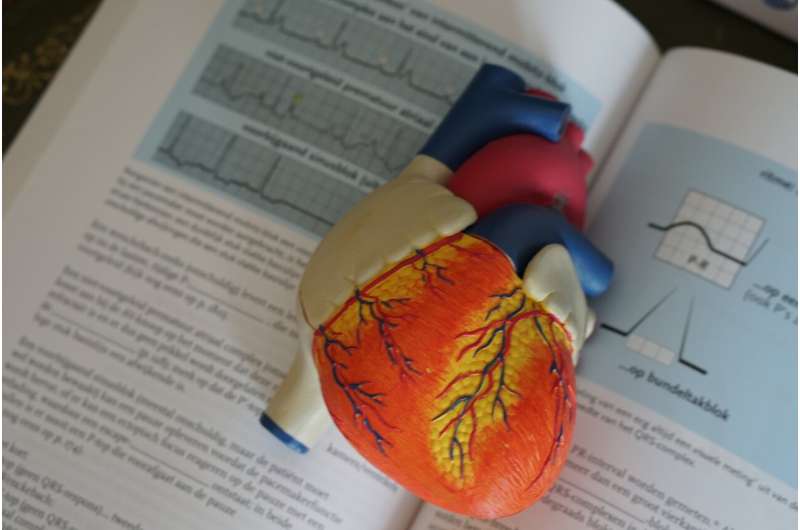October 30, 2023 report
This article has been reviewed according to Science X's editorial process and policies. Editors have highlighted the following attributes while ensuring the content's credibility:
fact-checked
peer-reviewed publication
trusted source
proofread
Trial of Chinese medicine compound Tongxinluo shows intriguing results with unclear active ingredients

A clinical trial led by Yuejin Yang of the Chinese Academy of Medical Sciences and Peking Union Medical College, China, has concluded that a Chinese traditional medicine compound, Tongxinluo, reduced major adverse cardiac and cerebrovascular events and reduced cardiac deaths.
In a paper, "Traditional Chinese Medicine Compound (Tongxinluo) and Clinical Outcomes of Patients With Acute Myocardial Infarction—The CTS-AMI Randomized Clinical Trial," published in JAMA, the researchers present a clinical trial result of an unclear combination of powdered plant and insect ingredients compared to a placebo in combination with a partially applied drug therapy for patients with acute ST-segment elevation myocardial infarction (STEMI).
The study involved 3,797 patients with ST-segment elevation myocardial infarction (STEMI) from 124 hospitals in China. Patients were randomized into two groups, taking either Tongxinluo or a placebo of four capsules, three times a day for 12 months or matching placebo.
Patients in the test group were given Tongxinluo, which the study describes as "... a traditional Chinese medicine compound, [sic] composed of powders and extracts from multiple plant and insect products." What plants, which insects, and the active compounds contained within are left unclear in the JAMA publication.
A previous publication by the group detailing the proposed study does offer a list of ingredients such as Chinese scorpions, leeches, Chinese cockroaches, Chinese red-headed centipedes, the sloughed outer shell of a cicada, Red peony root, Sour jujube seed, Agarwood, White Sandalwood, and synthetic borneol, a substance derived from camphor and known to be highly toxic.
Despite advances in treatment, patients with STEMI still face high risks of in-hospital mortality and recurrent cardiovascular events. The study aimed to assess the potential benefits of Tongxinluo as an add-on therapy in addition to STEMI guideline-directed treatments.
According to the results, Tongxinluo significantly reduced 30-day major adverse cardiac and cerebrovascular events (MACCEs) compared to the placebo group (3.4% vs. 5.2%) and showed improvements in individual components of MACCEs, including cardiac death and myocardial reinfarction. These beneficial effects persisted at 1-year follow-up.
During hospitalization, approximately 64% of the patients received beta-blockers, and ACE inhibitors or ARBs were prescribed to about 52% of patients. These utilization rates were lower at discharge, which may indicate that not all patients continued these medications after leaving the hospital. It is unclear from the study which patients continued or discontinued these medications beyond the hospitalization period, as no breakdown is provided.
The study clearly demonstrates the potential clinical benefits of some components within the complex compound of Tongxinluo as an add-on therapy in a sub-population of STEMI patients who may or may not have been taking a primary treatment drug. Precisely what that potential is remains clear as mud due to some major limitations.
Limitations
One of the study's primary limitations is a missing mechanism of action. While the study illustrates a clinical benefit in outcomes, it needs to provide a clearer understanding of how Tongxinluo exerts its effects.
This limits the ability to understand the specific physiological and molecular processes involved, especially with a multi-sourced compound, which severely undercuts a deeper understanding of the treatment's efficacy.
Suboptimal use of guideline-directed therapy
The study acknowledges that not all patients received the recommended guideline-directed medical therapy, a crucial part of the study design. For instance, the utilization rates of β-blockers and ACEIs/ARBs during hospitalization and at discharge were lower than expected.
This suboptimal adherence to guideline-directed therapy could potentially affect the interpretation of the results, as these therapies are known to reduce mortality in STEMI patients.
Low-risk patient cohort
The study reports that more than 90% of the enrolled patients presented with Killip class I, indicating a low risk of complications. This specific cohort of patients included in the study and the ever-confounding influence of the COVID-19 pandemic during the study period may not accurately represent the benefits of Tongxinluo in higher-risk patient populations, limiting the generalizability of the findings.
The limitations regarding guideline-directed therapy adherence, patient risk profile, unclear ingredient quantities and an unclear mechanism of action all highlight the need for further research to confirm and expand upon these findings.
While further research would be needed, it is difficult to imagine a Western clinical trial would attempt to repeat a trial with supplements containing ground scorpions, leeches, cockroaches and centipedes. That somewhere within the ingredient list of insects, plants and camphor extract could be hiding a compound with clinical relevance suggests that all the work is still ahead of any research on this subject, starting with what exactly is in the ingredients, which ones are active and how much was in the pill the patients took.
The Chinese government has a stated goal of pushing for patentable pharmaceutical applications for traditional Chinese medicinal ingredients in the hopes of integrating them with the Western pharmaceutical industry, specifically as adjunctive or add-on therapies.
This does add a level of research bias that cannot be avoided in any Chinese-based study on the subject. With continued efforts and funding underway, there will be many more studies like this, with intriguing outcomes and without relevant applications.
More information: Yuejin Yang et al, Traditional Chinese Medicine Compound (Tongxinluo) and Clinical Outcomes of Patients With Acute Myocardial Infarction, JAMA (2023). DOI: 10.1001/jama.2023.19524
© 2023 Science X Network




















